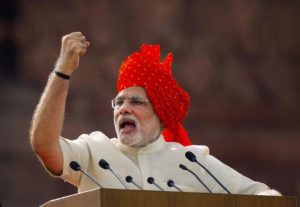Modicare for a healthier India?
Prime Minister Narendra Modi announced the ambitious healthcare scheme, Ayushman Bharat, in his last Independence Day speech ahead of next year’s general election. Will the roll-out be smooth? Or is it just another election gimmick to woo voters?
Addressing the nation from the ramparts of the Red Fort on Wednesday, Prime Minister Narendra Modi announced that ‘Ayushman Bharat’ would be rolled out on September 25, 2018 which is the birth anniversary of RSS-BJP ideologue, Deendayal Upadhyaya.
The healthcare scheme will provide insurance cover to a hundred million families or 500 million poor people, with an annual health cover of INR 5,00,000 or USD 7,200 to treat serious illnesses.
“We will be holding experiments in this sector for the next six to seven weeks, after which we will officially roll out the scheme,” Modi added.
The pilot scheme has been launched in eight states, including Uttarakhand, Haryana, Chhattisgarh, Manipur and Himachal Pradesh.
Modicare: In a nutshell
There are two components of the new health scheme. First is the creation of a nationwide network of 1,50,000 Health and Wellness Centres (HWCs), meant to provide comprehensive healthcare. The second is the overhyped insurance scheme, called the National Health Protection Scheme (NHPS). The eligibility is based on the Socio-Economic Caste Census (SECC) database.
In case of hospitalisation, beneficiaries need not pay a penny under the scheme provided they opt for any one of the government or empanelled private hospitals.
All kinds of diseases are covered from day one of the ‘Ayushman Bharat’ policy. The benefits covered include both pre and post hospitalisation expenses.
Beneficiaries need to carry a prescribed identity card to receive free treatment at the hospital. The existing sharing pattern ratio is 60:40 between the Central and state governments.
Why Modicare?
For the last seven decades, India has been successfully engaged in fighting maternal mortality and infant mortality under five. Control of communicable diseases has also been a priority.
Now the focus is on non-communicable diseases, specifically on prevention and early detection and treatment of hypertension, diabetes, chronic obstructive lung disease, common cancers, mental health, care of the aged, adolescent health, palliative healthcare, basic eye care and dental health.
The out-of-pocket expenses on medical treatment are quite high in India. The World Bank estimates that 62 pc of healthcare expenses in India are out-of-pocket.The Economic Survey for 2016–17 pointed out as much and noted that Indians faced higher out-of-pocket expenses on healthcare than their counterparts in the BRICS nations (Brazil, Russia, China and South Africa).
Significantly, China has lowered its out-of-pocket expenditure from 80 pc to 20 pc after it launched healthcare in 2009.
Challenges ahead
One of the key challenges facing the much-touted Modicare is getting all the states on board. So far, 22 states have preferred to run the scheme on the ‘trust model’. Punjab, Kerala, Maharashtra, Karnataka and Delhi are yet to come on board.
Odisha has launched a parallel scheme—Biju Swasthya Kalyan Yojana (BSKY)—following a disagreement with the Centre over the number of beneficiaries. Odisha scheme offers hospitalisation cover of up to USD 7,127 to men and USD 9,977 to women. Under the Indian Constitution, public health is a state subject and the federal government cannot force its scheme on the states.
So far, only 5,000 HWCs are ready. According to Health Ministry sources, many of these lack adequate number of doctors and nursing staff along with quality infrastructure. They were fast-tracked as several states agreed to partner with the Centre for the scheme.
Another challenge facing Modicare is the budgetary constraint. The budget allocated for 1,50,000 centres is a mere USD 171 million. The Modi administration had expected contributions from the private sector through CSR and also wants philanthropic institutions to adopt these centres.
Abhay Shukla of the Jan Swasthya Abhiyan and T Sundararaman, professor at Tata Institute of Social Sciences, have pointed out that additional budgetary allocation of about the USD 2,8508 (INR 2 million) per HWC per year, which means about USD 4.29 billion (INR 300 billion) per year would be required. There are no indications of any financial commitment.
Another significant issue that doctors point out with the proposed package rates is that most of them are way below the market rates. Also, hospitals may not be able to or want to operate on those costs. The scheme proposes a uniform cap of 1,00,000 or 5,00,000, on the insurance cover for all. Doctors argue that the schemes must look at diseases’ category-wise cover because, for example, a person who undergoes an organ or bone-marrow transplant will need expensive medicines for life, but that is not true for someone who has undergone other routine surgeries.
With so many challenges on the ground, one hopes Modicare really acts as a balm for those facing health emergencies. It should not turn into a mere election gimmick.










